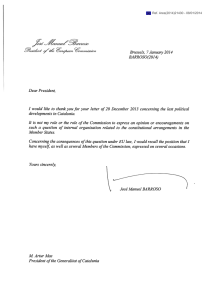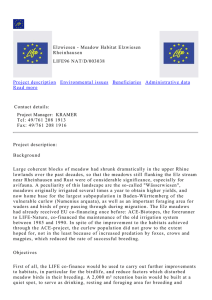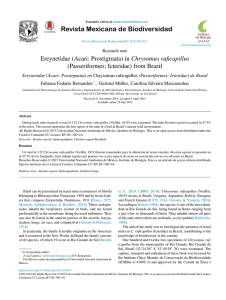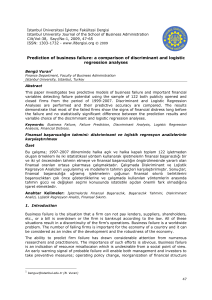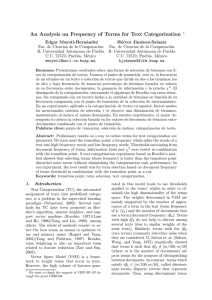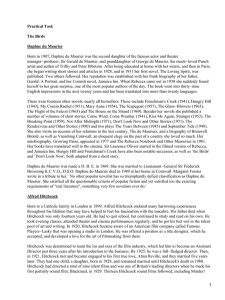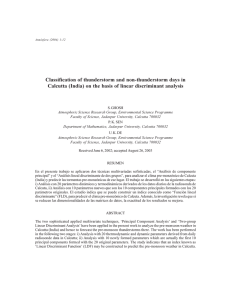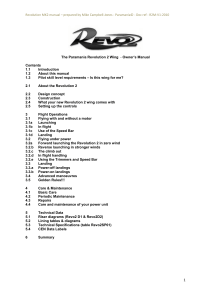Use of discriminant analysis in the sex determination of
Anuncio
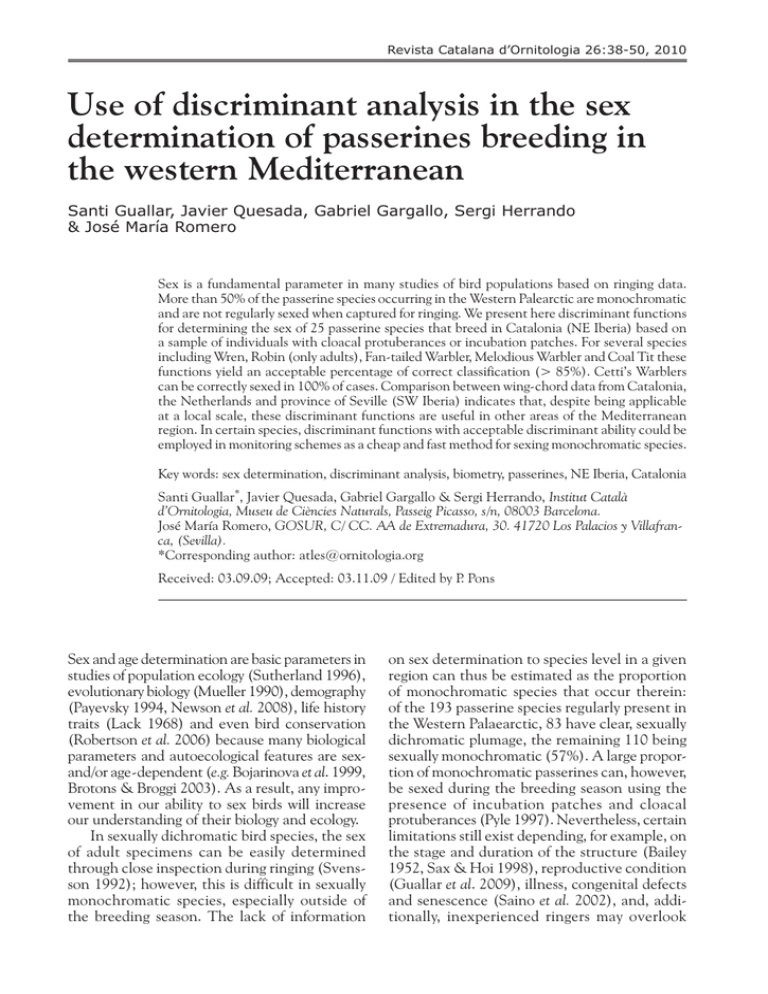
Revista Catalana d’Ornitologia 26:38-50, 2010 Use of discriminant analysis in the sex determination of passerines breeding in the western Mediterranean Santi Guallar, Javier Quesada, Gabriel Gargallo, Sergi Herrando & José María Romero Sex is a fundamental parameter in many studies of bird populations based on ringing data. More than 50% of the passerine species occurring in the Western Palearctic are monochromatic and are not regularly sexed when captured for ringing. We present here discriminant functions for determining the sex of 25 passerine species that breed in Catalonia (NE Iberia) based on a sample of individuals with cloacal protuberances or incubation patches. For several species including Wren, Robin (only adults), Fan-tailed Warbler, Melodious Warbler and Coal Tit these functions yield an acceptable percentage of correct classification (> 85%). Cetti’s Warblers can be correctly sexed in 100% of cases. Comparison between wing-chord data from Catalonia, the Netherlands and province of Seville (SW Iberia) indicates that, despite being applicable at a local scale, these discriminant functions are useful in other areas of the Mediterranean region. In certain species, discriminant functions with acceptable discriminant ability could be employed in monitoring schemes as a cheap and fast method for sexing monochromatic species. Key words: sex determination, discriminant analysis, biometry, passerines, NE Iberia, Catalonia Santi Guallar*, Javier Quesada, Gabriel Gargallo & Sergi Herrando, Institut Català d’Ornitologia, Museu de Ciències Naturals, Passeig Picasso, s/n, 08003 Barcelona. José María Romero, GOSUR, C/ CC. AA de Extremadura, 30. 41720 Los Palacios y Villafranca, (Sevilla). *Corresponding author: atles@ornitologia.org Received: 03.09.09; Accepted: 03.11.09 / Edited by P. Pons Sex and age determination are basic parameters in studies of population ecology (Sutherland 1996), evolutionary biology (Mueller 1990), demography (Payevsky 1994, Newson et al. 2008), life history traits (Lack 1968) and even bird conservation (Robertson et al. 2006) because many biological parameters and autoecological features are sexand/or age-dependent (e.g. Bojarinova et al. 1999, Brotons & Broggi 2003). As a result, any improvement in our ability to sex birds will increase our understanding of their biology and ecology. In sexually dichromatic bird species, the sex of adult specimens can be easily determined through close inspection during ringing (Svensson 1992); however, this is difficult in sexually monochromatic species, especially outside of the breeding season. The lack of information on sex determination to species level in a given region can thus be estimated as the proportion of monochromatic species that occur therein: of the 193 passerine species regularly present in the Western Palaearctic, 83 have clear, sexually dichromatic plumage, the remaining 110 being sexually monochromatic (57%). A large proportion of monochromatic passerines can, however, be sexed during the breeding season using the presence of incubation patches and cloacal protuberances (Pyle 1997). Nevertheless, certain limitations still exist depending, for example, on the stage and duration of the structure (Bailey 1952, Sax & Hoi 1998), reproductive condition (Guallar et al. 2009), illness, congenital defects and senescence (Saino et al. 2002), and, additionally, inexperienced ringers may overlook Sex determination of passerines using discriminant analysis or misinterpret the presence of these external structures. Discriminant analysis for the sex determination of sexually monochromatic species started to be applied to seabirds in the 1960s (Dunnet & Anderson 1961, Fox et al. 1981, Hanners & Patton 1985) and since the 1980s (e.g. Green & Theobald 1989) a number of studies have also addressed this issue in passerines. Specifically, in the Iberian Peninsula several species have been studied via this method, including Yellowhammer Emberiza citrinella (Aymí 1993), Red-billed Chough (Blanco et al. 1996), Spotless Starling Sturnus unicolor (Lezana et al. 2000), Corn Bunting Emberiza calandra (Campos et al. 2005), Citril Finch Serinus citrinella (Alonso & Arizaga 2006) and Southern Grey Shrike Lanius meridionalis (Gutiérrez-Corchero et al. 2007). This method seeks the linear combination of all or part of the measured variables that best discriminate between two or more naturally occurring groups within a sample and then uses these variables to predict group membership in any new cases (Huberty 1994). Discriminant analysis, however, has several shortcomings: it demands a moderate to large sample size, a sample of individuals of known sex, high repeatability of measurements and uncorrelated variables; it is also sensitive to outliers and usually only provides local applicability, as other factors (e.g. latitudinal increase in size as enunciated by the Bergmann´s rule) are prone to introduce noise into the analyses. These deficiencies can be overcome nowadays by employing techniques such as genetic sexing that permit the correct classification of over 99.9% of individuals (Griffiths et al. 1998, Lessells & Mateman 1998). Unfortunately, these techniques are costly and not available to all ornithologists. Discriminant functions become more powerful as the within-group dispersion diminishes and the between-group dispersion increases. Therefore, discriminant analysis is very sensitive to any source of error such as mis-measurement, mis-aging or mis-sexing that might alter these parameters. Provided that a measurement is taken in a standardarised fashion, its repeatability depends on factors such as year, age, abrasion and observer (even if the same standard is used by all observers), and in this study we control for the first two factors. The main objective of this work was to provide discriminant functions that would Revista Catalana d’Ornitologia 26 (2010) sex separately by age class the most frequently mist-netted monochromatic passerine species (and monochromatic juveniles of dichromatic species) that breed in Catalonia (NE Iberia). In order to show why sexual differences in biometry are of limited use, we also explored the influence of measurement errors in Cetti’s Warbler Cettia cetti and the effect of geography. For the latter effect we (1) compared the main variable selected in the discriminant analyses (wing chord) of birds from Catalonia with birds from a relatively close area (Seville province, SW Iberia) and a relatively distant area (the Netherlands); and (2) checked how the percentage of classification of our discriminant functions varies when applied to the dataset from Seville. Methods We used data for the maximum wing chord, p8 length and body mass of passerine birds trapped during field work, in addition to morphological variables for the Short-toed Treecreeper and the Coal Tit (Table 1; see Redfern & Clark 2001 for details) extracted from two other datasets: (1) the Catalan Ringing Office, which manages and coordinates ringing activities in Catalonia and centralises all ringing data, provided basic information from two long-term ringing programmes (MIGRACIO and SYLVIA; see http:// www.ornitologia.org/monitoratge/sylvia.htm for details) for the period 1991-2007; (2) the Ornithological Group of the South (GOSUR), which manages and coordinates ringing activities in Seville province, also provided data. Data selection for analyses We included 12 monochromatic and 13 dichromatic passerine species for which at least 10 individuals per sex class were available. For species with sexually dichromatic adult plumage, we only considered immature birds. We applied three filters before running the analyses: (1) To avoid mis-sexed birds, we considered males as birds recaptured at least once after a period of over 30 days that never had an incubation patch, regardless of whether or not the ringers had recorded the presence of a cloacal protuberance. We considered 39 S. Guallar et al. Revista Catalana d’Ornitologia 26 (2010) Table 1. Biometric variables registered in the Catalan dataset. Abbreviations and the precision of the measurement tools are shown. Maximum wing chord, p8 (numbered distally from the innermost primary) and body mass were taken in all species. Minimum tarsus length and bill length to the skull were additionally taken in the Short-toed Treecreeper. Minimum tarsus length, bill length and bill depth from distal end of nostrils, tail and P10 were measured for the Coal Tit. All measurements are as described in Redfern & Clark (2001). Variables biomètriques registrades per les dades de Catalunya. Es presenta la precisió dels instruments de mesura emprats i l’abreviatura utilitzada. A totes les espècies se’ls va prendre la corda màxima, la p8 (numerada de forma ascendent des de la més interna) i la massa corporal. Per al Raspinell també es va mesurar la longitud del tars mínima i la longitud del bec des del crani. Per a la Mallerenga Petita es va mesurar la primària més externa, la cua i la longitud i alçada del bec des de l’extrem distal de les narines. Totes les mesures estan descrites a Redfern & Clark (2001). All species Short-toed Treecreeper Certhia brachydactyla Coal Tit Parus ater wing chord (mm) C 0.5 C 0.5 C 0.25 p8 (mm) P 0.5 P 0.5 P 0.25 body mass (g) W 0.1 W 0.1 W 0.05 tarsus length (mm) — T 0.1 T 0.01 bill length from skull (mm) — B 0.5 — bill length from nostrils (mm) — — Bn 0.01 bill depth from nostrils (mm) — — Bd 0.01 tail (mm) — — Tl 0.25 p10 (mm) — — P10 0.25 females as birds that ringers annotated as females and had incubation patches. (2) To exclude migratory individuals, we only included in the analyses birds captured within certain time periods according to their migratory status: (a) resident species: from April until July, (b) partial and pre-Saharan migrants: from May until July, and (c) transSaharan migrants: from June until July. We considered only local birds in an attempt to reduce the noise introduced by birds of different origin (i.e. population), as these can differ not only in wing length and overall size (Alatalo et al. 1984, Groth 1993, Merom et al. 1999), but also in their degree of sexual dimorphism (this study). (3) To avoid pseudo-replicates (Hurlbert 1984), we only included in the data set the first capture per year of each bird. In addition, we applied specific filters to four species (Table 2) to take into account unusual moult strategies. Statistical procedures for sexing and ageing birds We calculated the repeatability (Ri) of the wing Table 2. Additional data filters accounting for the effect of moult. Filtres addicionals aplicats per controlar l’efecte de la muda abans de realitzar les anàlisis. Species Reed and Melodious Warblers Acrocephalus scirpaceus and Hippolais polyglotta House Sparrow Passer domesticus Sardinian Warbler Sylvia melanocephala 40 Moult extent New filter complete moult on winter grounds only birds in adult plumage complete post-juvenile moult juvenile birds that could be sexed before August and that had not yet moulted the primaries forming the wing tip post-juvenile moult includes the primaries constituting the wing tip juveniles captured between April and June prior to the onset of their primary moult Sex determination of passerines using discriminant analysis and p8 measurements according to Lessels & Boag (1987). We only took into account the first two captures of adult birds within the same year to avoid age-dependent variations. We analysed each species using the same routine. First, we obtained the mean and standard deviation of the biometric measurements mentioned above for each sex and age class. Second, we checked the variables for outliers, normality and the extent of correlation between wing chord and p8. For r2> 67%, we only selected one of the variables to perform the discriminant analysis. Lastly, we conducted a t-test on each variable in order to detect differences between age classes. If nonsignificant, we pooled all data. Additionally, two species that showed significant differences in p8 but not in wing chord were also pooled to attain the minimum sample size (n= 10) for performing the discriminant analysis (Song Thrush Turdus philomelos and Fan-tailed Warbler Cisticola juncidis). We performed discriminant analyses using all the available variables and selected the function that yielded the highest percentage of classification. We built the discriminant functions from the raw coefficients so that males yielded positive scores and females yielded negative scores (Table 3). We generated discriminant functions using the backward stepwise procedure described in Huberty (1994). As recommended by Frank et al. (1965), we only used 60% of the sample (calibration sample) to generate the function, while the remaining 40% was used to form the validation sample from which we estimated the percentages of correct classification. However, when the results derived from the validation sample were more optimistic than those of the calibration sample, we used the whole sample for classification. We randomized the data set for each species before performing the discriminant analyses. We set the probability for entering the predictors at 0.05 and the probability for removing them at 0.10. We specified the equal probabilities setting when the sex ratio (r= proportion of females) of the sample analysed for each species was r< 2/3; we considered this bias an artefact produced by the tendency of ringers to overlook cloacal protuberances. For discriminant functions that selected a single variable, we calculated the value of this variable for which a bird has a 95% probability of being a male or a female by equating logit(p)= ln [p/ Revista Catalana d’Ornitologia 26 (2010) (1-p)] as the score of the discriminant function (Green & Theobald 1989): logit (0.95)= 2.944 for a ‘95% male’ logit (0.05)= -2.944 for a ‘95% female’ We performed all the analyses with raw data since all variables were found to match normality. We set the p level at 0.01 to reduce the type I errors caused by the number of tests performed. All the analyses were run with Statistica 7.0 (StatSoft 2004). Comparison with other areas We compared the wing chord values obtained in Catalonia (mean latitude 41°2’ N) with those obtained for seven species in Seville province (mean latitude 37°2’ N, about 830 km from Catalonia) and for ten species in the Netherlands (mean latitude 52°2’ N, about 1250 km from Catalonia) with data taken from Cramp (1988, 1992) and Cramp & Perrins (1993, 1994). Of all northern European countries, the Netherlands has both the highest number of species and the most available data for the purposes of comparison. We avoided data from Great Britain to avoid insularity effects. As the values registered in Cramp (1988, 1992) are based on skin measurements, we multiplied them by 1.015 (i.e. we applied a 0.015 correction factor) to compensate for skin shrinkage (Winker 1993). We only compared those species for which data was available (n> 5) for the same age and sex classes as used for analysing birds in Catalonia. We also compared the coefficient of dimorphism between birds of these three areas. This parameter quantifies the difference in magnitude of one (or several) anatomical structures between two individuals or groups belonging to different classes. We calculated this coefficient as the quotient between the mean male and female wing chords. We considered the wing chord as the best univariate surrogate of size for comparison between species (Guallar et al. 2009). Results Sexing and ageing birds in Catalonia Wing chord measurements showed great variation 41 S. Guallar et al. Revista Catalana d’Ornitologia 26 (2010) Table 3. Discriminant functions. Age= Euring code. CI are the values of the variables at the 95% confidence interval for the Catalan dataset (available only for univariate functions). † indicates that the function is based on sex determination performed by the ringer. The headings Classif CAT and Classif SEV indicate the percentage of correct classification for the Catalan and the Seville datasets, respectively. Funcions discriminants. Edat= codi Euring. CI són els valors que prenen les variables en els intervals de confiança al 95 % per a la mostra de Catalunya (disponibles només per funcions univariants). † indica que la funció s’ha basat en la determinació del sexe per l’anellador. Les columnes Classif CAT i Classif SEV mostren els percentatges de classificació correcta per a les mostres de Catalunya i Sevilla, respectivament. CI 95% ( ; ) Classif CAT ( ; ) age function T. troglodytes >2 0.3721*C+0.3804*P-30.4661=0 P. modularis >2 0.6511*C-45.332=0 74.15; 65.10 72.2 (55.6; 77.8) E. rubecula 6 5 0.723*C-52.0198=0 0.6199*C-44.2468=0 76.02; 67.88 76.12; 66.63 87.0 (95.7; 84.2) 76.3 (82.6; 75.0) L. megarhynchos 6 5 0.5232*P-33.1489=0 0.6193*P-38.4629=0 68.98; 57.73 66.9; 57.35 66.2 (71.0; 65.5) 67.8 ( 58.3; 68.8) S. torquatus † 5 0.751*C-48.8545=0 68.97; 61.13 74.2 8 (73.2; 78.0) T. merula † 5 0.3296*C-40.675=0 132.33; 114.48 74.6 (81.5; 65.6) 125.10; 108.36 80.22.7 (100.0 ;77.5) Classif SEV ( ; ) [n] 91.0 (92.0; 90.7) 69.2 (81.8; 60.0) [n= 26] T. philomelos >2 0.3519*C-41.0772=0 C. juncidis † >2 0.5972*C+0.2626*P-39.815=0 6 0.8322*C-49.0181=0 62.44; 55.36 100 5 0.6824*C-38.3654=0 60.54; 51.91 99.4 (100.0; 99.2) A. scirpaceus 4 0.663*C-41.8341=0 67.54; 58.66 70.0 (70.6; 69.9) 80.0 (88.9; 72.7) [n= 20] H. polyglotta 4 0.7327*P- 36.7854=0 54.22; 48.19 86.9 (71.4; 88.5) 82.4 (62.5; 100) [n= 17] S. melanocephala † 3 0.7466*C-44.1578=0 63.10; 55.19 57.9 (59.1; 57.7) 65.2 (66.7; 63.6) [n= 23] S. atricapilla † 5 not possible C. cetti 93.6 (93.4; 94.0) R. ignicapilla † >2 0.7569*C-39.7539 56.41; 48.63 80.4 (81.0; 79.5) P. ater 4,6 3,5 0.701*C-44.5791=0 1.063*C-1.4434*B-55.2605=0 67.79; 59.39 88.5 (100.0; 70.0) 89.5 (77.8;100.0) C. caeruleus 6 5 0.549*C-35.3486=0 0.6361*P-30.7853=0 69.75; 59.02 53.03; 43.77 78.3 (88.2; 76.8) 76.4 (50.0; 79.6) L. cristatus 6 - 0.57698*P0.83393*W-36.56377=0 P. major 94.7 (100; 85.7) [n= 19] 100 (100; 100) [n= 10] 73.7 (66.7; 80.0) 5 0.5577*C-41.167=0 C. brachydactyla >2 0.6546*P+0.7911*B-45.8186=0 79.09; 68.53 73.9 (80.7; 68.3) 83.3 (83.3;83.3) R. pendulinus † >2 1.710299*W0.408749*C+7.960612=0 78.6 (85.7; 71.4) P. domesticus† 3 0.5377*C-30.1318=0 61.52; 50.55 65.7 (70.4; 61.1) F. coelebs † 5 0.4838*C-40.9495=0 92.73; 78.56 79.7 (71.0; 89.3) S. serinus † 5 0.5535*C-38.5916=0 75.04; 64.40 76.0 (77.8; 74.0) 60.0 (95.0; 25.0) [n= 40] C. carduelis † 5 0.5975*C-44.6662=0 79.68; 69.83 80.7 (82.1; 78.2) 75.5 (83.3; 68.0) [n= 49] E. cirlus † 5 0.4512*C-35.3801=0 84.94; 71.89 80.0 (67.3; 90.8) 42 Sex determination of passerines using discriminant analysis among species and ranged between Ri= 0.717 in Goldfinches Carduelis carduelis and Ri= 0.919 in Chaffinches Fringilla coelebs. Overall repeatability for the wing chord was remarkably high (Ri= 0.998,F1,6986= 1021.984, p<0.001) as expected. Males had significantly longer wings (Table 4), the only exception being the Blackcap Sylvia atricapilla. Male Coal Tits Periparus ater and Short-toed Treecreepers Certhia brachydactyla also had significantly longer tails (only marginally for the latter) and skeletal variables. In 12 species, females were heavier than males, probably due to gravidity during the measurement period (Ricklefs & Hussell 1984). Wing chord was selected as the only discriminant variable in 19 out of 29 cases. Only eight functions belonging to six species (for some species we derived functions for each age class) yielded reasonably good percentages of classification (> 85%; Table 3). Comparison to other areas With the exception of female Melodious Warblers Hippolais polyglotta, geographical comparisons between the average wing chord showed that there are no significant differences between birds from Catalonia and Seville province (p<0.01; Figure 1). By contrast, all species from the Netherlands showed significantly longer wing chords than those from Catalonia, with the exception of Robins, male Dunnocks and male Song Thrushes (p<0.01; Figure 1). These differences could be even larger as the data in Cramp (1988, 1992) and Cramp & Perrins (1993, 1994) is from skins and were probably taken using the unflattened wing method which yields lengths 0.8-4.7% shorter than the maximum wing chord (Svensson 1992). The coefficient of dimorphism in wing chord varied between the Netherlands and Catalonia by > 1% for all species except the Robin, whereas it only varies by > 1% between Catalonia and Seville for Blackbirds and Serins (Table 4). Interestingly, the percentage of correct classification slightly decreased for all species in the dataset from Seville except for Sardinian and Reed Warblers (Serins show a moderate decrease of -16%; Table 3). Discussion Sexual dimorphism in size in many monochromatic species is either absent or too small to Revista Catalana d’Ornitologia 26 (2010) sex birds and this study shows that in only six out of 25 species is this feature useful for this purpose (Tables 3 and 4). It should be taken into account that the discriminant functions that we derived use a very restricted set of biometric variables. Possibly, a larger set of variables (either biometric or plumage-based) would have allowed acceptable percentages of classification (> 85%) to be obtained for more species. Influence of measurement errors Repeatability provides a clue for assessing the influence of mis-measurement caused by the incorrect application of standard measuring techniques, mis-reading (probably the most influential factor due to the magnitude of the error it can induce, typically ± 5 mm) and mis-writing. The influence of errors on the discriminant function is revealed by collating the function for immature Cetti’s Warblers with the recaptures from the whole data base. The only two immature females incorrectly classified turned out to be a wrongly aged adult female and a wrongly sexed male, which had most probably been wrongly measured as well. Once this post-hoc filter is applied the discriminant function can be rewritten as 0.7012*C - 39.4113= 0 and the percentage of classification rises to 100%. Unfortunately, this correction phase is only possible if enough recaptures are available, but is still a strongly recommendable procedure. The chord repeatability obtained for Cetti’s Warbler is Ri= 0.93 (F1,446= 27.817, p<0.001), lower than the repeatability obtained in the studies by Senar & Pasqual (1997) for species such as Serin (Ri= 0.97) or by Cuervo & Møller (1999) for Mallards Anas platyrhynchos, Spotless Starlings Sturnus unicolor, Common Swallows Hirundo rustica and Lapwings Vanellus vanellus (Ri> 0.985), but still high enough to have confidence in the output of the quantitative analyses. The wing chord distribution by sexes for immature Cetti’s Warblers (Figure 2) illustrates how conservative the 95% intervals of confidence are: while the maximum value registered for females is 59 mm, the minimum confidence interval for an individual to be a male is set at 60.40 mm (after post-hoc correction). 43 S. Guallar et al. Revista Catalana d’Ornitologia 26 (2010) Table 4. Basic biometric descriptors by age and sex class for the species in question (mean and s.d. in mm). The age has been codified with the Euring code. CD is the coefficient of dimorphism calculated as the quotient between the means of each sex. An asterisk indicates significant differences (set at p< 0.01). Cat= Catalonia, Sev= Seville, Net= Netherlands, see Table 1 for other abbreviations. Descriptors bàsics de la biometria per edat i sexe de les espècies tractades (mitjana i s.d. en mm). L’edat correspon al codi Euring. CD és el coeficient de dimorfisme; s’ha calculat dividint les mitjanes de cada sexe. L’asterisc indica diferències significatives per a p<0,01. Cat= Catalunya, Sev= Sevilla, Net= Holanda, vegeu la Taula 1 per a les abreviatures. Age Wren T. troglodytes Dunnock P. modularis >2 >2 6 Robin E. rubecula 3,5 6 Nightingale L. megarhynchos 5 Stonechat S. torquatus Blackbird T. merula Song Thrush T. philomelos Fan-tailed Warbler C. juncidis 3,5 3,5 >2 >2 6 Cetti-s Warbler C. cetti 5 44 Variable (n ;n ) CD mean sd rank mean sd rank Cat C (26;100) * 49.04 1.66 46-52 45.48 1.48 41-49 1.08 P (26;98) * 37.40 1.08 35-39.5 34.46 1.23 32-37.5 1.09 W (26;99) * 9.55 0.49 8.5-10.6 8.83 0.88 7.0-11.4 1.08 C (34;56) * 70.84 1.59 68-75 68.34 1.66 63.5-73 1.04 P (34;57) * 54.21 1.42 51.5-57.5 52.51 1.38 50-55 1.03 W (33;56) 18.19 1.16 15.5-20.5 18.24 1.96 14.5-23.0 1,00 C (47;146) * 74.53 1.29 72-77.5 71.39 1.45 68-75 1.04 P (47;146) * 56.24 1.06 54-58 53.74 1.27 50.5-57 1.05 W (53;152) * 16.07 0.85 13.6-17.9 16.87 2.00 10.6-22.8 0.95 C (46;228) * 73.10 1.36 70.5-76.5 70.82 1.51 67-75 1.03 P (46;225) * 55.11 1.55 50-57.5 53.53 1.31 50.5-57.5 1.03 W (46;228) 15.79 0.84 14.0-17.7 16.40 1.86 12.8-24.1 0.96 C (32;202) * 83.20 1.38 81-85.5 81.47 1.98 73.5-87.5 1.02 1.02 P (31;197) * 64.52 1.49 62-67 62.97 1.86 56-67 W (34;199) 19.97 0.97 18.0-21.8 19.72 1.62 16.7-27.0 1.01 C (25;220) * 81.46 1.57 78.5-85 80.35 1.82 76-85 1.01 P (24;218) * 63.10 1.59 60.5-66 61.90 1.71 56-68 1.02 W (29;216) 20.28 0.91 18.4-22.3 19.73 1.70 14.9-25.9 1.03 C (194;50) * 65.48 1.51 61.5-70.5 63.98 1.16 60.5-68 1.02 P (195;50) * 49.95 1.36 46-54.5 48.53 1.17 45-50 1.03 Sev Net 1.06 1.04 1.03 1.03 1.02 W (187;49) * 14.00 0.76 11.9-16.6 14.84 1.46 10.4-18.8 0.94 C (707;543) * 125.18 2.99 115-137 121.31 2.96 111-132 1.03 1.03 P (679;517) * 95.08 2.65 87-107.5 91.96 2.63 83-102 1.03 1.02 W (719;562) * 84.46 5.32 65.5-114.0 85.70 6.19 68.1-109.0 0.99 0.82 C (10;71) * 120.8 1.06 119-123 116.17 3.00 111-126.5 1.04 P (10;69) * 92.30 1.32 90-94 88.39 2.66 83-96 1.04 W (11;70) * 64.99 4.55 61.5-76.0 72.05 5.90 61.0-89.6 0.9 C (301;118) * 51.03 1.38 45-56.5 47.6 1.29 45-51.5 1.07 P (297;117) * 38.29 1.21 34.5-41.5 35.75 1.30 32-40 1.07 W (302;117) * 9.13 0.57 7.3-11.0 8.66 0.75 7.0-11.6 1.05 C (44;89) * 63.3 1.31 61-67 55.76 1.2 53-59 1.14 1.12 1.01 P (43;86) * 48.23 1.09 46-51 42.03 0.95 40-44 1.15 1.12 W (48;84) * 15.50 0.80 13.0-17.3 11.90 1.27 9.8-15.8 1.3 1.36 C (46;132) * 60.79 1.46 58.5-64.5 54.44 1.41 51.5-58 1.12 1.17 P (45;130) * 46.30 1.28 44-49.5 41.09 1.11 38-44 1.13 1.16 W (43;126) * 15.00 0.61 13.1-16.3 11.79 1.16 9.6-16.1 1.27 1.50 Sex determination of passerines using discriminant analysis Age Variable (n ;n ) 4 Reed Warbler A. scirpaceus Melodious Warbler H. polyglotta Sardinian Warbler S. melanocephala Blackcap S. atricapilla Firecrest R. ignicapilla 4 5 5 >2 4,6 Coal Tit P. ater 3,5 6 Blue Tit C. caeruleus 5 Crested Tit L.cristatus 6 Revista Catalana d’Ornitologia 26 (2010) CD mean sd rank mean sd rank Cat Sev Net C (62;387) * 64.27 1.6 60-68 62.96 1.53 58-69.5 1.02 1.03 1.01 P (62;385) * 49.68 1.59 46-53 48.72 1.49 43.5-54.5 1.02 1.03 W (64;381) * 10.09 0.53 8.7-11.7 10.59 1.04 8.5-14.1 0.95 0.93 C (28;264) * 67.54 1.47 65-70 64.8 1.48 61-70 1.04 1.07 P (28;262) * 52.23 1.22 50-54.5 49.85 1.38 45-54.5 1.05 1.05 W (28;262) 10.52 0.64 9.5-12.3 10.93 1.09 8.6-15.4 0.96 1.03 C (49;367) * 59.48 1.37 56.5-62 58.87 1.56 52-64 1.01 1.04 P (48;364) * 45.47 1.25 43-48 45.02 1.25 40.5-49 1.01 1.03 0.97 W (49;380) 11.88 0.84 10.2-14.1 12.23 0.95 10.2-16.3 0.97 C (956;882) 72.1 1.78 66-78 72.05 1.78 66.5-78.5 1,00 P (941;871) 55.53 1.61 51-61.5 55.5 1.65 50-60 1,00 W (959;878) * 16.50 1.24 13.4-22.9 17.3 1.42 12.7-23.0 0.95 C (149;99) * 53.65 1.32 50-57 51.14 1.26 47.5-54 1.05 P (146;97) * 41.67 1.30 38-44.5 39.71 1.25 36.5-42.5 1.05 W (149;102) * 5.25 0.31 4.5-6.5 5.50 0.57 4.4-7.9 0.95 C (40;22) * 64.51 1.18 61-68 62.02 1.32 59-63.5 1.04 P (26;12) * 50.08 1.34 47.25-52 48.21 0.86 47-49.75 1.04 P10 (20;9) 17.19 1.27 14.25-19 17.39 1.22 15.25-19 0.99 Tl (38;22) * 48.78 1.53 46-53 47.06 1.23 45-50 1.04 T (40;22) * 17.11 0.43 16.25-17.8 16.82 0.39 16-17.4 1.02 Bn (38;20) * 7.82 0.26 7.1-8.4 7.99 0.29 7.4-8.5 0.98 Bd (38;20) * 3.45 0.15 3.2-3.8 3.35 0.11 3.1-3.5 1.03 W (39;21) 9.47 0.41 8.6-10.1 9.15 0.62 8.25-10.75 1.03 C (27;Valid N) * 64.00 1.09 61-65.5 61.39 0.91 60-63.5 1.04 P (9;26) * 49.14 1.28 47.5-51 47.78 1.17 45-50.25 1.03 P10 (2;18) 19.75 1.77 18.5-21 17.69 0.95 15.25-19 1.12 Tl (26;26) * 48.26 1.22 46-51 46.12 1.09 44-48 1.05 T (26;12) * 17.28 0.3 16.5-17.71 16.93 0.42 15.9-17.6 1.02 Bn (21;26) * 7.73 0.31 7.1-8.15 7.93 0.32 7.4-8.6 0.97 Bd (21;25) * 3.37 0.13 3.15-3.6 3.41 0.14 3-3.7 0.99 W (26;25) 9.41 0.43 8.25-10.25 9.28 0.59 8.25-10.5 1.01 C (17;112) * 67.15 1.81 63-70 64.14 1.68 59-69 1.05 P (15;104) * 51.77 1.35 49.5-54 49.46 1.65 45-54 1.05 W (21;121) 10.22 0.60 9.0-11.1 10.4 1.03 8.4-13.0 0.98 C (14;130) * 64.61 1.52 62-66 62.64 1.65 59-68 1.03 P (10;125) * 50.35 0.94 49-51 48.47 1.54 43-54 1.04 W (17;136) 10.33 0.69 9.0-12.0 10.52 1.04 7.2-13.7 0.98 C (15;34) * 65.87 1.76 62-69 62.99 1.93 58.5-68.5 1.05 P (12;33) * 50.50 1.04 49-52 48.04 1.62 45-53 1.05 W (19;31) 10.97 0.73 9.0-12.1 10.39 0.82 8.6-13.0 1.06 1.00 1.04 45 S. Guallar et al. Revista Catalana d’Ornitologia 26 (2010) Age Variable (n ;n ) C (336;324) * Great Tit P.major Short-toed Treecreeper C. brachydactyla Penduline Tit R. pendulinus House Sparrow P. domesticus Chaffinch F. coelebs Serin S. serinus Goldfinch C. carduelis Cirl Bunting E. cirlus 5 >2 >2 3 5 5 5 5 CD mean sd rank mean sd rank Cat 75.06 2.01 69-80 72.37 1.66 68-77 1.04 1.04 P (326;314) * 57.64 1.72 52.5-63 55.44 1.38 51.5-60 W (344;333) 17.17 1.06 14.4-23.6 17.21 1.37 13.9-21.0 1,00 C (30;17) * 62.35 1.46 59.5-66.5 59.76 1.59 58-64 1.04 P (30;17) * 47.63 1.05 45.5-49.5 45.53 1.15 44-47.5 1.05 1.03 Tl (7;6) 57.43 4.49 49.5-62.5 56 5.05 49-61 Bs (30;18) * 19.65 0.89 17.5-21.1 17.71 0.86 16.4-19.45 1.11 W (30;18) 8.39 0.51 7.6-9.8 8.42 0.97 7.0-10.5 1,00 C (42;29) * 54.92 1.52 52-59.5 53.74 1.07 52-56.5 1.02 P (42;29) * 41.96 1.36 39.5-45.5 40.97 1.08 39-43.5 1.02 W (42;28) * 8.04 0.52 7.2-9.8 8.96 0.80 7.0-10.5 0.9 C (73;75) * 75.27 1.89 70-79 73.75 2.45 67-79 1.02 P (75;75) * 56.53 1.61 51.5-60 55.36 1.76 52-59.5 1.02 W (78;77) 25.83 2.13 19.6-32.3 25.45 1.98 21.2-29.4 1.01 C (72;69) * 87.22 2.24 81-92 82.33 1.80 79-88 1.06 P (72;70) * 68.49 1.93 64-73 64.57 1.45 62-69.5 1.06 W (70;70) 20.73 1.15 18.9-24.5 20.63 1.70 17.4-25.7 1,00 71.16 1.80 66-77 68.59 1.79 62-74 1.04 1.04 P (372;335) * 55.45 1.75 50-61 53.4 1.49 50-57 1.04 1.05 W (362;337) * 10.76 0.60 9.0-13.0 11.45 0.96 9.4-16.2 0.94 0.92 C (171;286) * 76.58 1.58 71-81.5 73.83 1.76 69-79.5 1.04 1.03 P (172;285) * 59.60 1.56 53.5-64.5 57.32 1.70 52-62 1.04 1.03 W (169;286) 14.61 0.90 10.1-18.0 14.67 1.04 11.8-17.9 1,00 0.98 C (65;55) * 80.17 1.95 75-85.5 76.89 1.90 71-83.5 1.04 P (63;53) * 62.12 1.51 58.5-65.5 59.18 1.60 54-64.5 1.05 W (66;55) 23.52 1.15 19.2-26.7 24.79 2.38 20.1-32.5 0.95 The differences in size between individuals of the same species breeding in different regions clearly indicate that the discriminant functions here derived are only locally or regionally applicable and thus we must be well aware of the origin of the data to be used before they are employed. Furthermore, the variation in the coefficients of dimorphism suggests that their discriminant power may vary within these areas. Nevertheless, the percentages of classification that we have obtained for Cetti’s and Melodious Warblers in southwest Spain using the discriminant functions derived from northeast Net 1.05 C (369;338) * Influence of differences in geographic origin 46 Sev Spain are probably equally powerful (Table 4). Hence, our data suggest that they may be useful for sexing birds of several species in the Mediterranean area. In spite of these drawbacks, discriminant analysis has certain features that make it a recommendable tool: it is more powerful than plumage colouration as a sex predictor in juveniles (Borràs et al. 1993, Alonso & Arizaga 2006) and is cheaper and sometimes as accurate as genetic techniques of sex determination, thereby making it a very valuable tool for monitoring schemes, especially in undeveloped countries. Despite the failure of the great majority (if not all) of current European and American ringing schemes to use discriminant functions Sex determination of passerines using discriminant analysis Revista Catalana d’Ornitologia 26 (2010) 140 females Catalonia 130 Seville Netherlands wing chord (mm) 120 80 70 60 50 CARCAR SERSER CERBRA REGIGN SYLATR SYLMEL HIPPOL ACRSCI CETCET TURPHI TURMER SAXTOR LUSMEG ERIRUB PRUMOD TROTRO 40 140 males Catalonia 130 Seville Netherlands wing chord (mm) 120 80 70 60 50 CARCAR SERSER CERBRA REGIGN SYLATR SYLMEL HIPPOL ACRSCI CETCET TURPHI TURMER SAXTOR LUSMEG ERIRUB PRUMOD TROTRO 40 Figure 1. Wing chord: mean and standard deviation. The name of each species is shown as a combination of the first three letters of its generic and specific names. Corda alar: mitjana i desviació estàndard. Es mostra el nom de cada espècie amb les tres inicials del gènere i de l’epítet específic. as a sexing tool, their implementation would increase the number of sexed birds in their data bases and hence the power and scope of their analyses. We thus encourage ringing scheme coordinators to consider the development and application of these functions in analyses based on their data bases. Acknowledgements This study was supported by the Department of Environment and Housing of the Catalan Government as part of the work of the Catalan Ringing Office and the SYLVIA and Migration projects. We are thankful to Pere Pons, Mariano Cuadrado and an anonymous reviewer for their valuable comments, which improved this manuscript. We are especially grateful to all the invaluable work of the ringers 47 S. Guallar et al. Revista Catalana d’Ornitologia 26 (2010) 100 females frequency 80 60 males 40 20 0 50 52 54 56 58 60 62 64 66 wing chord (mm) Figure 2.Frequency distribution for the chord of immature Cetti’s Warblers before the post-hoc correction. Distribució de freqüències de l’ala (corda màxima) dels immadurs de Rossinyol Bord abans de la correcció post hoc. from Catalonia and Seville who provided the data analysed in this work. Resum Utilització d’anàlisis discriminants en la determinació del sexe en espècies de passeriformes que crien a l’àrea mediterrània El sexe és un paràmetre fonamental en molts estudis de poblacions d’ocells. Tanmateix, més del 50% dels passeriformes que es troben al Paleàrtic occidental son monocromàtics i romanen sense sexar en els protocols dels projectes de monitoratge. Aquest estudi presenta funcions discriminants per a 25 espècies de passeriformes que es capturen de manera freqüent a Catalunya, a partir de la mostra d’individus amb protuberància cloacal o placa incubatriu. Per al Cargolet, el Pit-roig (només adults), el Trist, la Bosqueta Vulgar i la Mallerenga Petita les funcions donen percentatges de classificació acceptables (> 85%), mentre que la del Rossinyol Bord permet sexar correctament el 100% dels casos. La comparació entre individus de Catalunya, els Països Baixos i Sevilla indica que les funcions discriminants que es presentem aquí tenen una aplicabilitat local, tot i que algunes d’elles poden ser adoptades en altres àrees de la regió mediterrània. Les funcions discriminants es podrien emprar en programes de seguiment per a aquelles espècies per a les 48 quals donin percentatges de classificació acceptables com a mètode ràpid i econòmic per sexar espècies monomòrfiques. Resumen Utilización de análisis discriminantes en la determinación del sexo en especies de paseriformes que nidifican en el área mediterránea El sexo es un parámetro fundamental en muchos estudios de poblaciones de aves. Sin embargo, más del 50% de las paseriformes que se encuentran en el Paleártico occidental son monocromáticas y no se sexan en los protocolos de los proyectos de monitoreo. Presentamos funciones discriminantes para 25 especies de paseriformes que se capturan con frecuencia en Cataluña, a partir de la muestra de individuos con protuberancia cloacal o placa incubatriz. Para el Chochín, el Petirrojo (sólo adultos), el Buitrón, el Zarcero Común y el Carbonero Garrapinos las funciones proporcionan porcentajes de clasificación aceptables (> 85%), mientras que la del Ruiseñor Bastardo permite sexar correctamente el 100% de casos. La comparación entre individuos de Cataluña, de los Países Bajos y Sevilla indica que las funciones discriminantes que aquí se presentan tienen una aplicabilidad local aunque pueden ser adoptadas en otras áreas de la región mediterránea. Las funciones Sex determination of passerines using discriminant analysis discriminantes se podrían emplear en programas de seguimiento para aquellas especies para las que proporcionen porcentajes de clasificación aceptables como método rápido y económico para sexar especies monomórficas. References Alatalo, R.V., Gustafson, L. & Lundberg, A. 1984. Why do young passerine birds have shorter wings than older birds? Ibis 126: 410–415. Alonso, D. & Arizaga, J. 2006. Biometrics of Citril Finch Serinus citrinella in the west Pyrenees and the influence of feather abrasion on biometric data. Ringing & Migration 23: 116–124. Aymí, R. 1993. Sex- and age-related differences in the biometrics of a wintering population of Yellowhammers Emberiza citrinella. Butll. GCA 10: 1–7 Bailey, R.E. 1952. The incubation patch of passerine birds. Condor 54 (3): 121–136. Blanco, G., Tella, J.L. & Torre, I. 1996. Age and sex determination of monochromatic non-breeding choughs: A long-term study. J. Field Orn. 67: 428–433. Bojarinova, J.G., Lehikoinen, E. & Eeva, T. 1999. Dependence of juvenile moult on hatching date, condition and sex in the Great Tit. J. Avian Biol. 30 (4): 447–459. Borràs, A., Cabrera, J., Colomé, X. & Senar, J.C. 1993. Sexing fledglings of cardueline finches by plumage color and morphometric variables. J. Field Orn. 64 (2): 199–204. Brotons, L. & Broggi, J. 2003. Influence of morphology on winter residence and recruitment in juvenile coal tits (Parus ater) after the post-fledging period. Ecoscience 10 (3): 273–282. Campos, F., Hernández, M., Arizaga, J., Miranda, R. & Amezcua, A. 2005. Sex differentiation of Corn Buntings Miliaria calandra wintering in northern Spain. Ringing & Migration 22: 159–162. Cramp, S. (ed.) 1988. The Birds of the Western Palearctic. Vol. V. Oxford: Oxford University Press. Cramp, S. (ed.) 1992. The Birds of the Western Palearctic. Vol.VI. Oxford: Oxford University Press. Cramp, S. & Perrins, C.M. (eds.) 1993. The Birds of the Western Palearctic. Vol. VII. Oxford: Oxford University Press. Cramp, S. & Perrins, C.M. (eds.) 1994. The Birds of the Western Palearctic. Vol. IX. Oxford: Oxford University Press. Cuervo, J.J. & Møller, A.P. 1999. Evolutionary rates of secondary sexual and non-sexual characters among birds. Evol. Ecol. 13: 283–303. Dunnet, G.M, & Anderson, A. 1961. A method of sexing living Fulmars in the hand. Bird Study 8: 119–126. Fox, G.A., Cooper, C.R. & Ryder, J.P. 1981. Predicting the sex of Herring Gulls by using external measurements. J.Field Orn. 52 (1): 1–96. Frank, R.E., Massy, W.F. & Morrison, D.G. 1965. Bias in multiple discriminant analysis. J.Marketing Res. 2: 250–258. Green, P.T. & Theobald, C.M. 1989. Sexing birds by discriminant analysis: further considerations. Ibis 131(3): 442–447. Revista Catalana d’Ornitologia 26 (2010) Griffiths, R., Double, M.C., Orr, K. & Dawson, R.J.G. 1998. A DNA test to sex most birds. Mol. Ecol. 7: 1071–1075. Groth, J.G. 1993. Evolutionary differentiation in morphology, vocalizations, and allozymes among nomadic sibling species in the North American red crossbill (Loxia curvirostra) complex. University of California Publications in Zoology 127. Guallar, S., Santana, E., Contreras, S., Verdugo, H. & Gallés, A. 2009. Passeriformes del Occidente de México: biometría, datación y sexado. Barcelona: Museu de Ciències Naturals de Barcelona. Gutiérrez-Corchero, F., Campos, F., Hernández, M.A. & Amescua, A. 2007. Biometrics of the Southern Grey Shrike Lanius meridionalis in relation to age and sex. Ringing & Migration 23: 141–146. Hanners, L.A. & Patton, S.R. 1985. Sexing Laughing Gulls using external measurements and discriminant analysis. J. Field Orn. 56 (2): 158–164. Huberty, C.J. 1994 Applied Discriminant Analysis. New York: John Wiley. Hurlbert, S.H. 1984. Pseudoreplication and the design of ecological field experiments. Ecol. Monog. 54 (2): 187–211. Lack, D. 1968. Ecological adaptations for breeding in birds. London: Methuen & Co. Lessels, C.M. & Boag, P.T. 1987. Unrepeatable repeatabilities: a common mistake. Auk 104 (1): 116–121. Lessells, C.M. & Mateman, A.C. 1998. Sexing birds using random amplified polymorphic DNA (RAPD) markers. Mol. Ecol. 7: 187–195. Lezana, L., Miranda, R., Campos, F. & Peris, S.J. 2000. Sex differentiation in the spotless starling (Sturnus unicolor, Temminck 1820). Belgian J. Zool. 130 (2): 139–142. Merom, K., McCleery, R. & Yom-Tov, Y. 1999. Agerelated changes in wing-length and body mass in the Reed Warbler Acrocephalus scirpaceus and Clamorous Reed Warbler A. stentoreus. Bird Study 46: 249–255. Mueller, H.C. 1990. The evolution of reversed sexual dimorphism in size in monogamous species of birds. Biol. Rev. 65: 553–585. Newson, S.E., Evans, K.L., Noble, D.G., Greenwood, J.D. & Gaston, K.J. 2008. Use of distance sampling to improve estimates of national population sizes for common and widespread breeding birds in the UK. J. Applied Ecol. 45 (5): 1–9. Payevsky, V.A. 1994. Age and sex structure, mortality and spatial winter distribution of Siskins (Carduelis spinus) migrating through eastern Baltic area. Vogelwarte 37: 190–198. Pyle, P. 1997. Identification guide to the North American birds Part I. Bolinas: Slate Creek Press. Redfern, C.P.F. & Clark, J.A. 2001. Ringer’s manual. Thetford: British Trust for Ornithology. Ricklefs, R.E. & Hussell, D.J.T. 1984. Changes in adult mass associated with the nesting cycle in the European Starling. Ornis Scandinavica 15 (3): 155–161. Robertson, B.C., Elliott, G.P., Eason, D.K., Clout, M.N. & Gemmell, N.J. 2006. Sex allocation theory aids species conservation. Biol. Letters 2 (2): 229–231. Saino, N., Ambrosini, R., Martinelli, R. & Møller, A.P. 2002. Mate fidelity, senescence in breeding 49 Revista Catalana d’Ornitologia 26 (2010) performance and reproductive trade-offs in the Barn Swallow. J. An. Ecol. 71 (2): 309–319. Sax, A. & Hoi, H. 1998. Individual and temporal variation in cloacal protuberance size of male Bearded Tits (Panurus biarmicus). Auk 115 (4): 964–969. Senar, J.C. & Pasqual, J. 1997. Keel and tarsus length may provide a good predictor of avian body size. Ardea 85: 269–274. StatSoft, Inc. 2004. STATISTICA (data analysis software system), version 7. www.statsoft.com. 50 S. Guallar et al. Sutherland, W.J. 1996. From individual behaviour to population ecology. Oxford: Oxford University Press. Svensson, L. 1992. Identification guide to European passerines. Stockholm: Svensson. Winker, K. 1993. Specimen shrinkage in Tennessee Warblers and “Traill’s” Flycatchers. J. Field Orn. 64 (3): 331–336.
